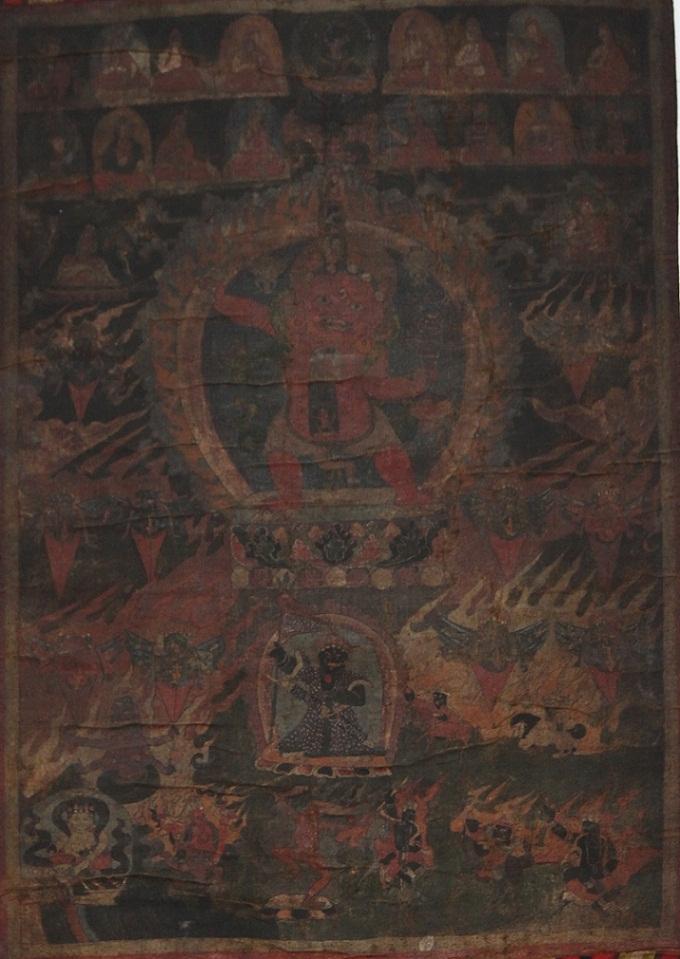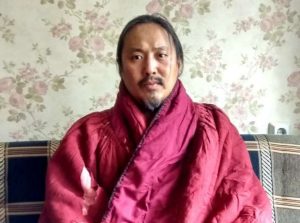
A member of the Bhutanese Royal Family, Princess Ashi Kesang Choden T. Wangchuck is executive director of Bhutan’s Thangka Conservation Center and a scholar of ancient Buddhist scriptural texts and iconography. In this she follows in the footsteps of her grandmother, Her Majesty the Queen Grandmother Kesang Choden Wangchuck, who is a generous supporter of cultural preservation and of research and scholarship on the kingdom. Princess Ashi Kesang has written three books on Bhutan and published numerous articles. For some time, she was home-schooled by the great Nyingmapa lama His Holiness Dilgo Khyentse Rinpoche (1910–91) as her family wanted her to develop a deep knowledge of Buddhism.
Recently Princess Ashi Kesang traveled to Hong Kong, where she had been invited by the Asia Society Hong Kong Center to give a talk on the work of the Thangka Conservation Center. She also kindly allowed Buddhistdoor to interview her on the preservation of Bhutan’s cultural heritage.
Buddhistdoor: Your Royal Highness, I understand that it is your personal goal to promote and preserve the Kingdom of Bhutan’s cultural heritage. Could you tell us more about your aspiration?
Princess Ashi Kesang: Well, it’s not so much a personal aspiration as a collective one. There are others who are doing a much better job than I am, for example the Monastic Body, who are usually the custodians of our cultural heritage, and there are so many other people who need just that extra step to get there. I’m trying to help in that way.
BD: How much of Bhutan’s cultural heritage is on public display?
PAK: I’m being optimistic here, but I would say five per cent. A lot of the objects and sacred items that we have are actually in the monasteries themselves, so unless you go hiking for eight hours you’re not going to be able to see them! The ones that are accessible to the public are usually on view only during festivals.
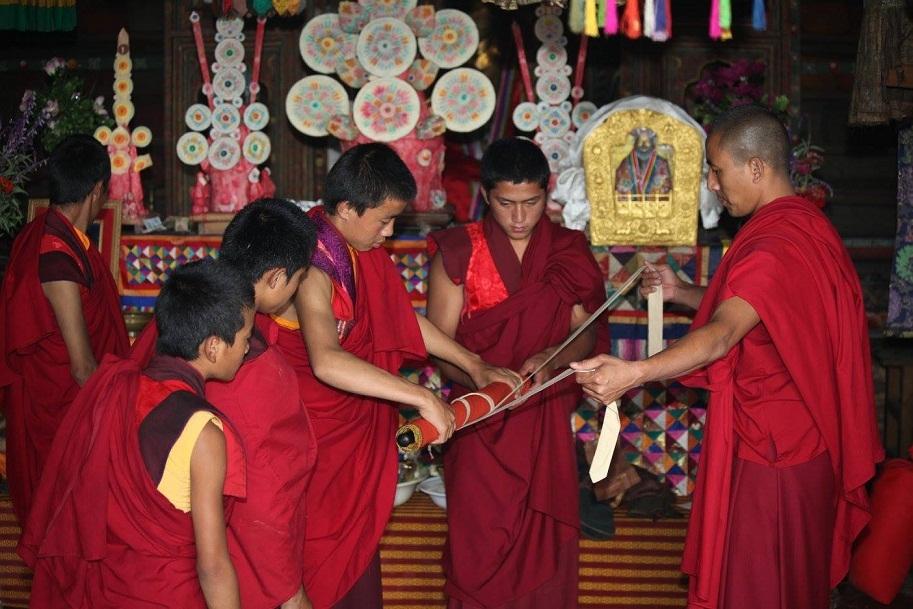
BD: Are there any museums?
PAK: Yes, but I wouldn’t say that the most precious or rare objects are in the museums. We do have some old objects, but the most important ones are usually kept in the monasteries as sacred objects.
BD: So are the objects in the museums on loan?
PAK: Yes. They belong to certain communities or monasteries, and they’re always quite anxious to get them back! Many people are really worried because, as Buddhist practitioners, we feel that having that spiritual object with us brings blessings and spiritual benefit to the community and to the monastery. People get quite anxious if it’s not there.
BD: I remember hearing that everybody was quite concerned about the objects going to America and Europe for The Dragon’s Gift, the traveling exhibition of Bhutanese art in 2008–10.
PAK: Yes! I know it was just a two-year traveling exhibit, but it actually took ten years to convince everybody, from His Majesty the King right down to the villagers. The villagers were like, “What do you mean, it’s going to travel outside? It hasn’t even left the threshold!” So they were quite concerned.
BD: There were a lot of pujas, and so on.
PAK: Yes, many prayers were done. A lot of monks went traveling with the objects. It was quite a big responsibility for them.
BD: So would you say that local people are generally interested in their cultural heritage?
PAK: When they’re children, it gets passed on from family. So for example, my grandmother used to always tell me stories when we went to monasteries. It would sort of be history and spiritual background, but at the same time sort of in a story. Then of course you get to that certain age where you’re a teenager, and a lot of teenagers are into K-pop and things like that, but once they reach their twenties a lot of them really get into spiritual practice. So I’m quote hopeful that the young generation are still interested in passing on their culture and preserving it.
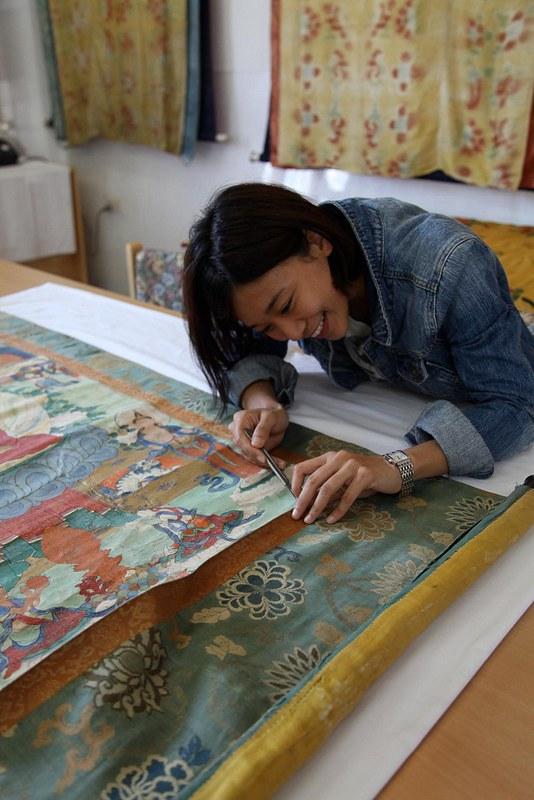
BD: Dzongsar Khyentse Rinpoche remarked in an interview with the Bhutan Broadcasting Service that Bhutanese art, and people’s ability to appreciate their art, is stagnant, probably because the Bhutanese are overly paranoid about maintaining [their] old traditions.
PAK: Rinpoche is quite right to a certain extent. A lot of the older generation are more involved with Buddhist practice based on blind faith, but a lot of the younger generation question the meaning behind it. I think conservation is a good way to go about it because it is an educational way of teaching people the meaning behind an object. For example, we had a summer retreat with high-school students, and they wanted to know the significance behind lighting a butter lamp, they wanted to know why we do meditation practice. Of course, I’m not a teacher or anything, but I was explaining to them the way I understand it, that it’s more to do with training and transforming the mind, and they understood it in that way. I tried to explain how there have been scientific experiments showing that meditation changes the brainwaves and things like that. I was telling them those kinds of things, and that was very relatable to them. That was something that they could do, not something based on blind faith, but something that they understood and that they were able to practice. So I think in that way it can change.
BD: I read that Bhutan currently has no UNESCO World Heritage Sites, but that it has had eight declared tentative sites for UNESCO inclusion since 2012. Do you have any updates?
PAK: We are still working on it. Those eight that we had registered, one of them [Wangdue Phodrang Dzong] got burned down a couple of years ago, so the government is very anxious to get the other sites that we’ve put forward on the UNESCO list. We’re hoping that it will happen by spring next year.
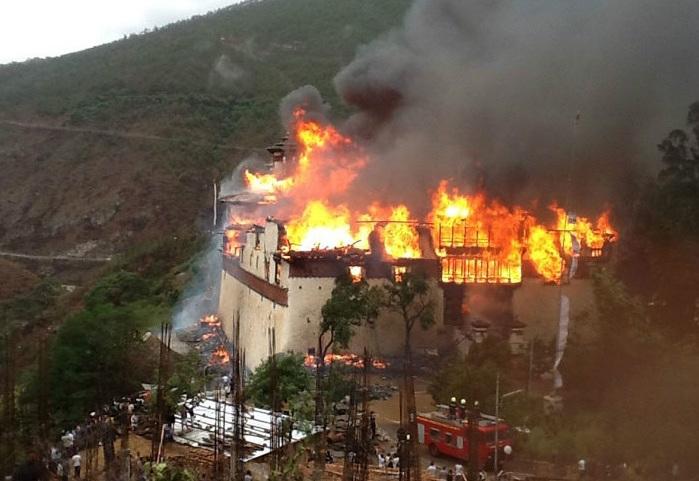
BD: Can you tell us more about the conservation efforts at the Thangka Conservation Center, of which you are the executive director? What kind of problems do you face? And to whom or which institutions do the thangkas belong?
PAK: Firstly, we do conservation on the government level—we have a Department of Culture, and the Home Ministry supports conservation work. The other part is of course the Monastic Body. Twelve years ago, [Asian art conservator] Eddie Jose* decided to teach the monks, so we have a group there. The difficulties that we have are of course mostly financial—I think that goes for conservators worldwide. Secondly, I think the geographical conditions are quite difficult. Other countries don’t have this difficulty—people bring the pieces to the museum or to the conservatory and then they take them back. In Bhutan, a lot of the pieces are not museum pieces and they’re not kept in homes that are accessible by road—things like that. Last year, the monks had to walk for about seven or eight hours to get to a monastery and they had to stay in this monastery and do the work there, so it’s mostly on-site work. We have over 2,000 monasteries, so it’s quite a bit of exercise and effort!
BD: Are the monks fully trained now?
PAK: Yes. Three of them are teachers, and they’ll be teaching the next generation of monks—they already began last year. The new ones are pretty enthusiastic about their work, so I’m happy with that!
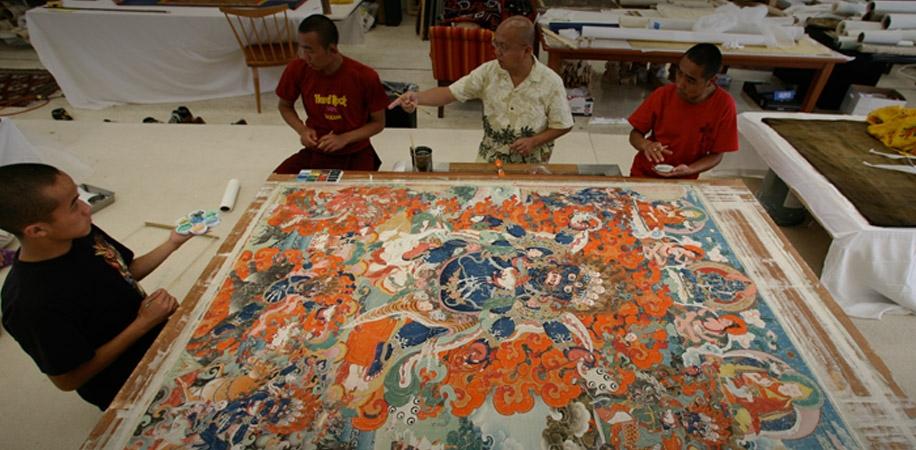
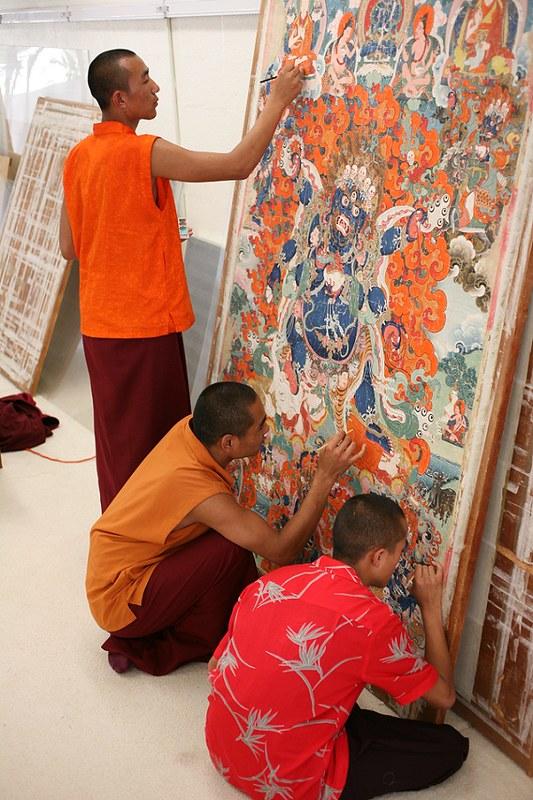
BD: I understand that the monks initially had some resistance to conservation.
PAK: Yes, I think they didn’t understand the concept. The Buddhist concept of conservation is making merit, so you offer your physical self in order to make merit—for example, you might restore a thangka or a monastery. In the olden days it was fine because you used the traditional equipment, like masonry, mud, mineral paints, things like that. But now, in modern times, they only want the quickest and easiest way—“Let’s go buy some synthetic paint! Let’s get brand-new silk!”—which might not be 100 per cent silk. So Eddie told them they couldn’t do that, that it was about quality and doing it old-school style. And they would say, “But it takes time! We don’t have time!” This is the issue when you become a modern country and have economic development. We have to decide which is the best way to do it so that it really keeps the aesthetic and spiritual value of the piece.
BD: You get the paints from Japan, I heard.
PAK: Traditionally we used to get the mineral paint from Tibet, but it’s a bit difficult now. So currently we usually get it from Japan, and then we mix our traditional colors with it to try and get the right tone.
BD: People have different ideas about conservation. Some think that restoring a piece to its former glory is important, but others may feel that that amount of restoration is too much.
PAK: I think the monks and I argue about this every day! But we have set certain standards. For example, for Buddhist practice you need the iconography to be complete. If the paint has cracked and the eye is missing, or perhaps the mudra, then maybe we will just touch it up very lightly so that when you look at it from a distance you’re able to see it as a complete deity. As you know, we use it for visualization practice, so in order to do that, the deity has to be complete so that we understand the subtleties of the wisdom blessings that we get. But at the same time, Western conservators just clean up water damage or insect damage, things like that, and leave the cracks and things. In some areas we do that. Each thangka is actually its own case.
BD: Do you consecrate the restored pieces?
PAK: Yes, we have to do a blessing ceremony. The Bhutanese would be not happy if the pieces were not blessed.
BD: How old are the earliest thangkas that you have in Bhutan?
PAK: So far, the earliest one we have found is 14th century. That’s in Central Bhutan. It belongs to a monastery that was founded by the tertön [treasure revealer] Pema Lingpa, one of the five major tertöns in the Nyingma lineage, and depicts a vision that he had—he was visiting Guru Rinpoche’s paradise. In the next couple of years we’ll see if we can find anything earlier.
BD: Is the iconography similar to Tibetan thangkas, or is there quite a big difference?
PAK: Some similarities are there, of course. A lot of the aspects such as the landscape and things like that are borrowed from Tibet, as well as from China and India. But Bhutanese thangkas have their own uniqueness in that the landscape also reflects the flora and fauna that’s available only in Bhutan—that’s how you can identify whether a thangka is Bhutanese. Also, [the thangkas depict] lamas that had perhaps not had much influence in Tibet [but who] had a great influence in Bhutan, like the Drukpa Kagyu lineage and Zhabdrung Rinpoche.**

BD: The Drukpa Kagyu lineage of Vajrayana Buddhism is the state religion in Bhutan. Would you say that being Buddhist defines the Bhutanese identity?
PAK: To a certain extent, yes. Buddhism has had a big influence on our culture and history. Even our national dress and the etiquette and so on hail from Buddhist origins. But the true essence of Bhutan, I think, is more like the essence of humanity—having compassion, having loving-kindness, having integrity. I think these are the things that embody what it is to be human.
BD: So are people still interested in Vajrayana as Bhutan becomes more modernized?
PAK: I think we’re at a crossroads at the moment. We still have to develop the economy. It’s a fine balance. There are some aspects of society that are not the best—there’s more crime, there are young children who take drugs or who are lost because they come from broken families—there are issues like that that we face, just like every other country. We’re not Shangri-La like everyone likes to advertise! Yes, we might have been slow to open up to modernization, but we are facing these issues. And we’re fortunate to have leaders that are wise enough to lead by example. I think in that way we still have some hope in moving in a positive direction.
* Ephraim “Eddie” Jose was the chief conservator behind the groundbreaking exhibition The Dragon’s Gift: The Sacred Arts of Bhutan. For 11 years he lived in Japan, where he trained with the late master conservator Tatsuji Handa, and in late 1998, he was the first non-Japanese to be certified by the Japanese Agency for Cultural Properties. As well as his work with thangkas, Eddie has restored Japanese, Chinese, and Korean paintings for museums and collectors.
** Zhabdrung Rinpoche refers to Ngawang Namgyal (1594–1651), the Tibetan lama who founded the Bhutanese state.
For more information about the Thangka Conservation Center, see the website Druk Foundation for Art Preservation
Buddhistdoor is grateful to the Asia Society Hong Kong Center for facilitating the interview.




